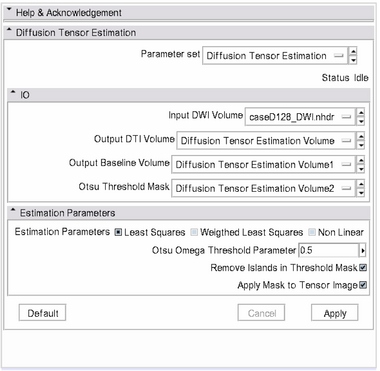Modules:DiffusionTensorEstimation-Documentation-3.6
Return to Slicer 3.6 Documentation
Module Name
Diffusion Tensor Estimation
General Information
Module Type & Category
Type: CLI
Category: Diffusion MRI Applications
Authors, Collaborators & Contact
- Author: Raúl San José Estépar, BWH
- Contributor: Gordon Kindlmann, University of Chicago
- Contact Information
Module Description
This module estimates the diffusion tensor model from a Diffusion Weighted Image (DWI) Volume. The result is a tensor volume that can be used to compute different anisotropy measurements, for example Fractional Anisotropy, and perform tractography.
Usage
Examples, Use Cases & Tutorials
- Compute DTI volume from DWI. It is the first step of any pipeline that employs DTI to assess white matter structure.
Quick Tour of Features and Use
The module takes one DWI volume and computes a DTI volume. The parameters are the following:
- Input/Output: Defines input and output files.
- Input DWI Volume is the input DWI volume,
- Output DTI Volume is the DTI volume that will be estimated.
- Output Baseline Volume is the average of the B0 images (non-diffusion weighted images) of the DWI sequence. This volume is useful to have a structural representation of the DTI volume .
- Otsu Threshold Mask is an approximated mask of the white matter that can be used to filter out the background.
- Estimation Parameters:
- Least Squares: Least Squares estimation method. This is the method by default and the most stable [Basser, 2002].
- Weighted Least Squares: WLS estimation method based on Salvador's method that takes into account the Rician noise model in the MRI signal to weight the least square fitting by the magnitude of the DWI signal. This method implementation is still experimental [Salvador, 2005].
- Non-linear: direct non-least squares fitting of the tensor model to the data without log-transformation. This method is experimental.
- Otsu Omega Threshold Parameter: weight that controls the otsu threshold. Smaller numbers create larger masks.
- Remove Island in Tensor Mask: if active, holes in the produced mask will be removed.
- Apply Mask to Tensor Image: Mask output DTI volume with the computed mask. Tensor outside the mask will be set to zero.
Development
Dependencies
None
Known bugs
Follow this link to the Slicer3 bug tracker.
Usability issues
Follow this link to the Slicer3 bug tracker. Please select the usability issue category when browsing or contributing.
Source code & documentation
Links to documentation generated by doxygen.
More Information
Acknowledgement
This module has been developed at Laboratory of Mathematics in Imaging (LMI). The functionality of this module is provided by the Teem library (http://teem.sourceforge.net/) This work is part of the National Alliance for Medical Image Computing (NAMIC), funded by the National Institutes of Health through the NIH Roadmap for Medical Research, Grant U54 EB005149.
References
- P. J. Basser and D. K. Jones. Diffusion-tensor MRI: theory, experimental design and data analysis - a technical review. NMR Biomed, 15(7-8):456–67, 2002.
- R. Salvador, A. Pena, D. K. Menon, T. A. Carpenter, J. D. Pickard, and E. T. Bullmore. Formal characterization and extension of the linearized diffusion tensor model. Hum Brain Mapp, 24(2):144–55, 2005.
